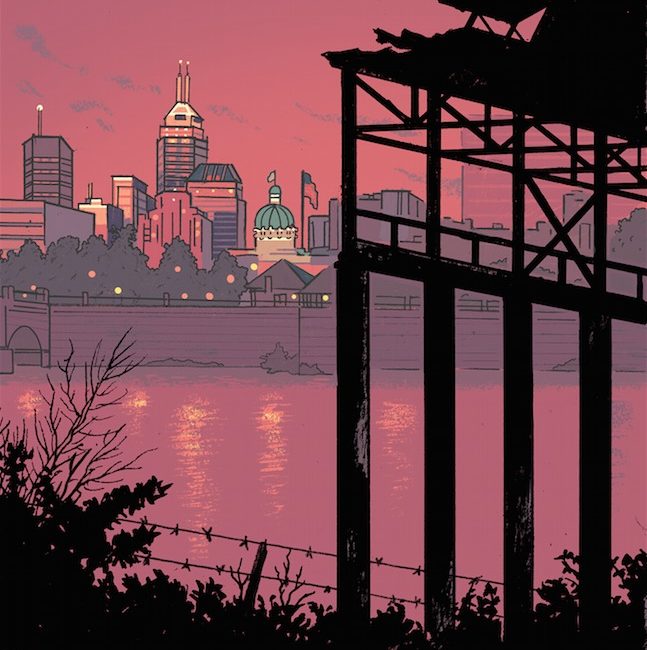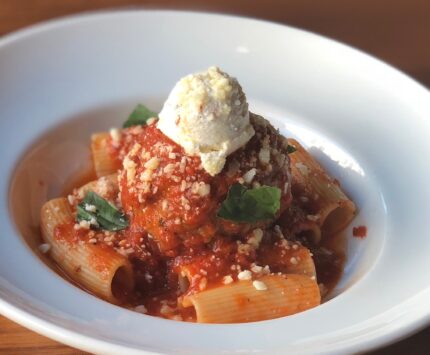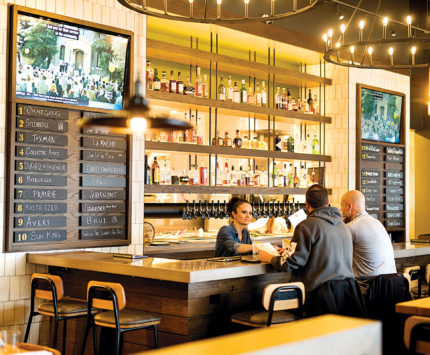Inside The City’s $550 Million Flub

Waterside: Indy’s Fantasy Land Illustration by Curt Merlo
Less than three years ago, the future of the General Motors stamping plant site looked as shiny as a new Chevy Camaro. Although the 103 acres across the White River from downtown had been vacant since 2011, the city and a trust formed to oversee the land were determined to attract a transformational development. A call for proposals went out nationwide. Dreamers proposed everything from an aquarium to a theme park. And the winning idea came from hometown Ambrose Property Group: a massive $550 million mixed-used neighborhood it eventually named Waterside.
The plan was unapologetically ambitious for a company with fewer than 30 employees and no experience attempting something on that scale. Initially, it called for 250 apartments, a hotel, and office and retail space. “This is a tremendous milestone for the citizens of Indianapolis and Marion County, the Valley neighborhood, and our downtown core,” Mayor Joe Hogsett said in a press release at the time. The excitement about the site’s potential only intensified in January 2018, when Amazon announced Indy was one of 20 finalists in a competition to land its second headquarters and up to 50,000 jobs. Few cities would be able to offer a plot so large and close to downtown.
But Amazon never came, and neither did Waterside. After committing to a 15-year plan that would have added 30 city blocks and as many as 12,000 jobs to the west side of downtown, Ambrose pulled out of its agreement with the city in September, citing a desire to shift its focus to its e-commerce and industrial real-estate business. Soon after, the city learned Ambrose had already sold 12 acres of the site to the Indianapolis Zoo—and had declared its intent to seek a buyer for the rest. That led Hogsett’s office to send a letter threatening to seize the remaining 91 acres via eminent domain. Which prompted Ambrose to sue for breach of contract and to halt those efforts. Both sides now appear to be in for a lengthy court battle.
Today, a “HelloWaterside.com” sign still hangs from a rusty gate at the bleak entrance to the GM stamping plant site, its crisp white lettering not yet sun-bleached. But it’s clear that not only will Waterside never happen, a transformative mixed-use district of any kind seems unlikely. Because of the enormous infrastructure improvements necessary, some experts say the site was never a promising location for one in the first place.
Nearly 50 years ago, more than 5,000 Hoosiers went to work at a new GM factory west of downtown with the square footage of 78 football fields. The Valley, a small neighborhood south of the site between the White River and Harding Street, was home to many of them. When the plant opened, the neighborhood saw an influx of workers who shopped, ate, and played in the thriving community. But as production began to decline in the 1970s and I-70 sliced through the area, stores in the once-bustling Oliver Avenue shopping district shut their doors, and many residents left for other places.
Even as downtown experienced a multimillion-dollar revival a few blocks away in the ’80s and ’90s, The Valley struggled. Cut off by the river from the growth and crisscrossed by railroads, the pinned-in neighborhood had a single two-lane road looping out to the north and a decaying bridge to the east. That had never been a problem for the small community that lived there, but with the closure of the GM stamping plant in 2011, the limited connection to the city was suddenly conspicuous.
The groups that proposed to redevelop the site in the coming years were aware of that infrastructure problem. In 2013, a trust called Revitalizing Auto Communities Environmental Response (RACER) took ownership of the land and made a call for proposals to reimagine it. After reviewing them, RACER selected REI Investments’s plan to build a $40 million concert venue at the site. According to Mike Wells, president of REI, the scant roads in and out of the neighborhood wouldn’t have been a huge obstacle for his amphitheater. The volume of traffic it created wouldn’t have warranted additional bridges or widened roads. And when then-Mayor Greg Ballard proposed adding a $500 million criminal-justice center nearby, it lessened the pressure on REI to develop it alone. But after the Ballard administration’s plans fell through, Wells terminated his firm’s contract with RACER—he says REI couldn’t secure financing—and, in July 2015, the site went back on the block.
Indy Eleven owner Ersal Ozdemir made a bid for the site, for which he was considering a long-planned soccer stadium, among other things, according to Indianapolis Business Journal. But RACER ultimately chose another bidder: Ambrose Property Group, owned by Aasif Bade and Patrick Chittenden, who has since left for undisclosed reasons. (Both declined to be interviewed for this story.) Despite being smaller and decades younger than its competitors, Ambrose had long been punching above its weight. In the two years before it bid for the GM site, Ambrose beat out 29 other developers to construct a $45 million Mishawaka medical facility for the U.S. Department of Veterans Affairs, landed a partnership to build a $33 million headquarters for Allied Solutions, LLC in Carmel, and was selected to erect a $20 million office building for Stanley Security in Fishers. Even though Ambrose was small, it had an experienced management team. Bade had completed more than $200 million in transactions as an executive at Duke Realty Corp. Chittenden had been a project manager at Meyer Najem Construction before leaving to launch Ambrose with Bade in 2008.
“People thought, Wow, that’s a really aggressive plan for that site,” says Mike Wells, president of REI Investments.
Tom Gallagher, who led RATIO Architects’s concert-venue design for the site, suspects Ambrose set itself apart because of its engagement with The Valley. “They didn’t hire typical real-estate development folks for the project,” he says. “They hired people whose job it was to engage the neighborhood.”
According to Jay Napoleon, president of The Valley Neighborhood Association, Ambrose made the residents’ desires a priority. “The folks that did the previous bidding wouldn’t talk to us,” Napoleon says. “So it was surprising when Ambrose showed us what they were planning, and said point blank, ‘If you guys aren’t going to be for this, we won’t bid.’”
Ambrose also had the backing of the city—something Wells says RACER made clear was important in the selection process. (RACER’s redevelopment manager, Bruce Rasher, declined an interview request for this story, but said at the time that the trust was consulting with the city on its selection.)
Nevertheless, when RACER chose Ambrose’s $550 million mixed-use proposal, the decision raised eyebrows in the development community.
“People thought, Wow, that’s a really aggressive plan for that site,” Wells says. “Especially with construction costs rising and oversupply starting to catch up downtown. But Ambrose has a history of being successful at making aggressive acquisitions, so you had to give them credit.”
After Ambrose agreed to buy the property from RACER for $3 million in May 2017, it signed a project agreement with the city that guaranteed the developer up to $26.7 million in infrastructure funds for the first phase of its development.
In 2018, citing the increased demand for downtown office space among other things, Ambrose expanded its original vision of a $550 million, 2.7-million-square-foot district to a $1.4 billion, 8-million-square-foot behemoth. It asked the city for tens of millions of dollars more in public subsidies as the infrastructure costs of the project nearly tripled to $75 million for widening multiple streets and bridges, sewer upgrades, and adding a pedestrian bridge across the river.
After the city declined to provide it, the Waterside deal collapsed and Ambrose said it couldn’t move forward without the additional funds. It’s unclear whether the firm’s announced decision to pursue another line of business was a result of that failure, or an excuse. But Wells says the city’s unwillingness to provide more incentives would have been a deal breaker for his company as well. The infrastructure needs for the sprawling Ambrose project were much greater than would have been required for the concert venue, and the result was inevitable.
“I totally agree with Ambrose,” he says. “It’s a very, very difficult site to develop, and when the city said they weren’t going to increase the subsidy, the risk for the developer just got too great.”
Like most major developments these days, Ambrose’s vision was supposed to be financed by Tax Increment Financing. The city expanded the downtown TIF district to encompass the GM site in 2016, seemingly setting the stage for a blockbuster public-private partnership. Under the terms of a TIF agreement, any property taxes generated by new homes or businesses a developer builds go toward paying down future debt on infrastructure projects in the district. “Basically, you’re getting a loan off your property,” says Gallagher, the RATIO architect.
But TIF districts don’t always guarantee successful development.
“Indianapolis isn’t flush with cash,” Gallagher says. “And most developers don’t have enough money in the bank to do the kind of infrastructure that’s required over there.” He characterizes it as a chicken-and-egg dilemma. “The developer is like, ‘OK, you want to help us out with TIF funds, but we can’t build anything to generate those funds until there are roads,’” he says. “Somebody has to invest something up front.”
None of this should have been a surprise to Ambrose or the city. A 2011 Urban Land Institute study commissioned by Indianapolis identified the site’s isolated location from a transportation perspective as one of its major challenges—and recommended a mixed-use development only if an industrial user couldn’t be found. (RACER attempted to sell the site as a stamping plant for two years, but couldn’t find a buyer.) The report noted a need for a bevy of improvements to the site—intersection enhancements to Harding Street and sewer upgrades among them—and concluded that development would require “significant public investment in infrastructure to support the private investment.” The panel was confident that the city could find the public money, based on its “history of creative financing with tax increment financing and infrastructure funds.” Yet the hypothetical plan it was considering had an estimated cost of no more than $370 million over 10 years, not $1.4 billion.
The city continues to push for a mixed-use district when some in the industry believe it will not work.
Other challenges the panel flagged included a lack of transportation to the site, active rail lines along the property’s northern edge, and a legacy of industrial use dating to the 1830s, when mills dotted the White River.
An executive at one of Indy’s largest developers of apartments and condos, who asked to remain anonymous, believes those challenges suggest a better use for the land. “If you think about the site, it has been industrial for 100 years,” he says. “The neighborhood has grown up around it as an industrial site. Neighborhoods change, but that one has not. It would be a lot less of a transformation to make it an industrial development.”
But the Urban Land Institute report underscored why a property unsuited for a massive mixed-use development was nevertheless so tempting. The authors noted that they were encouraged to “Think big,” “Be bold,” and take advantage of “a rare opportunity to create a higher and better use for the site.”
Wells says Hogsett was thinking in the same vein. “The city wanted a massive development on the site—all mayors do,” he says. “And Ambrose presented the most aggressive plan, which allowed the city to justify the incentives.”
As if the GM stamping plant site didn’t already face enough hurdles, Ambrose and the city are now ensnared in a legal battle. After Hogsett’s administration threatened to seize the land via eminent domain, Ambrose sued for breach of contract. Even if the development firm could legally sell the land, interest in it is negligible, Bade claims, without a guarantee of infrastructure funds from Indianapolis. “The city’s unlawful threats have thus frozen all activity at the site because no developer will invest in the property until the city’s threats are removed,” he said in a statement announcing the lawsuit in November.
But neither the lawsuit nor the challenges to the site have kept the city from pursuing a transformational mixed-use district there. Although Hogsett declined to be interviewed for this story, the city’s attorney, Donnie Morgan, said in a statement that they’re still committed to a mixed-use plan in line with Ambrose’s original 2017 proposal. Morgan noted development at the property “has the potential to catalyze the surrounding neighborhoods and bring economic opportunities to the area.” He did not elaborate on why the city continues to push for such a district when some in the industry believe it will not work.
Wells and others doubt the city will see a second chance at that kind of development. Gallagher points to the availability of competing sites. “The fact that you have all that land together doesn’t outweigh the fact that there are better places to develop apartments and condos downtown,” he says.
What might be easier to say is what the site likely won’t be: an Indy Eleven stadium or a concert venue. An Indy Eleven spokesman said in November that the site was not being considered for the club’s stadium, and with a $17 million upgrade at the Lawn at White River State Park set to open this summer, a proposal for a dueling amphitheater less than a mile away now seems unlikely.
Gallagher believes it still might be possible to create a mixed-use development of some kind if several developers partnered to share the risk and costs. Wells, on the other hand, remains convinced that the ideal use is an office-warehouse plan that capitalizes on the site’s proximity to the interstates.
“But sexy apartments, condos, and retail?” he says. “I don’t see it happening.”





